Dress as an element of the image of a woman always says a lot: her taste, status, character. In the 60s of the last century, this rule became controversial, because in the fashion world there were big changes. London became the mecca of all stylish people, the skirts became incredibly short, and the almost boyish thinness became touchingly sweet. Dresses emphasized sexuality, which was combined with the laconicism of form and color. New prints and drawings, new styles and names appeared.

Style features
In the 60s in all areas of life there was a search for new forms and innovative thinking. The austerity of shapes and geometric purity of the lines were contrasted with overly lush dresses and short skirts. Women showed their individuality in unusual combinations. Classics required a new facet, and fragile models similar to Twiggy gained wide popularity.


Dress-shirts, safari, culotte appeared. The first ladies and style icons demonstrated new styles and were not afraid of the length of the mini. The dress was the center of the image, so all other details complemented it, giving a finished look. Many styles were so successful that they are successfully used today, almost unchanged and retaining their attributes in the form of accessories and jewelry.
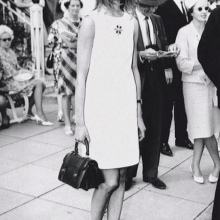


Who is it for?
Retro clothes are designed for different shapes and types, so everyone can find their perfect dress:
- There are many options for slim and fragile young ladies - these are almost all straight and shortened models, options with geometric prints and plain ones with contrasting trim in the form of a collar and cuffs.
- A trapezoid, A-silhouette will help girls “rectangles (balanced volumes of the chest and hips, a slightly pronounced waist).
- For ladies with forms you can find worthy options: puffy skirts, open shoulders and bare arms in medium length emphasize femininity.
- Wide hems will help to distract attention from large shoulders.
- Tall girls will especially like the trapeze model, culott (jumpsuit), shirt dresses, safari.
- The hippie style highlights the slim.
- Easy fullness and a small tummy will hide loose styles.
- A flared and large fold on the skirts will easily replace the baby-doll style and fit into modern ensembles, making a favorable emphasis on the hips and legs.






Colors and prints
A distinctive feature of that time was the bright saturated colors of clothes: green, light green, yellow, pink, blue blue, space and shiny shades of fabrics in gold and silver.



Fluffy skirts were beaten by peas, stripes and a cage, a romantic floral print. Laconic cut models in the choice of drawing were stricter. Plain fabrics were selected for the à la Twiggy dress, softening the rich color of the finish, or relied on a geometric pattern. Straight dresses helped create the silhouette by applying the optical effects of lines and color.
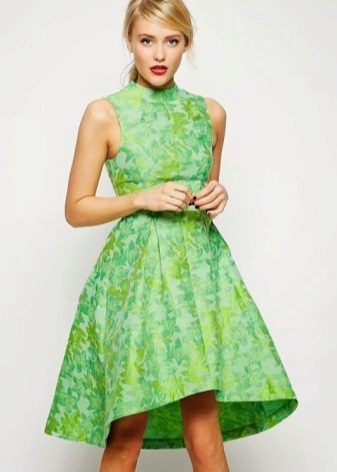




New patterns - psychedelics - featured avant-garde fashion designers. But haute couture willingly used their favorite colors - black and white. Feminine models continued to sew from natural fabrics - chintz, silk, crepe de chine, wool and knitwear. Fashionistas liked advanced artificial fabrics (nylon, rayon, artificial leather, etc.)



Trapezoid
Very simple and emphasized naive style when the skirt expands to the bottom. The length of the dress varies from mini to midi. It helps to focus on the legs, distracts attention from the top and waist. A comfortable and functional dress goes well with knee-high socks, stylized tights and stockings.

For the image you need shoes on medium or small heels, boots. Cross straps, buckles, lacing well complement the image. Stylists recommend paying attention to universal low boats.


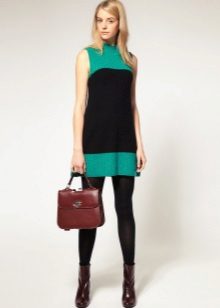
Lush
Long and short dresses with a full skirt became a trend not only in the 60s.

Fashion designers actively use this image, and the style itself regularly appears on red carpet and prestigious ceremonies. Volume helps create a layered fabric. In shortened versions, it is successfully compensated by large folds. The peculiarity of the dress is a distinguished waist, which will add femininity to the figure. Top styles with a long and short sleeve, without sleeves or with a neckline were relevant. As a separate option known baby doll.




Dudes
This phenomenon took place in the Soviet Union. It was difficult to sew fluffy dresses of midi length in bright colors in a monophonic version or with a simple pattern like peas. The color was considered defiant, the style impractical and western.

Modern fashionistas like to use this style for costume parties. Intricately styled hairstyle and neat perfect make-up, copying the icons of beauty of the 60s, help to properly “submit” the dress. Straight dresses and a-line came a bit later, like flared and hippie fashion.


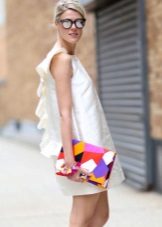

Evening
Evening dresses were distinguished by femininity and sexuality. This is best conveyed by lush long dresses.

They can be distinguished by impeccable cut and conciseness (in the style of Givenchy) or combined with a rich finish, lace (reminiscent of Dior). Plain dresses made of expensive or natural stones make up sets with accessories of a different color. Dear and precious metals with precious stones complement the sophisticated look. A special charm will create pearls.




Wedding
Formal dresses of that time are distinguished by their opposite: a short straight pastel pink dress from Givenchy and puffy long dresses with bare shoulders in a la baroque lace. Smooth fabrics or lace trim are a matter of taste.

Wedding models of the 60s have changed little. Much attention was paid to trifles for this event: neat hats, delicate veil, small handbags, elegant gloves, discreet jewelry.


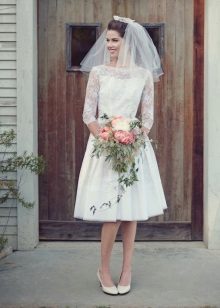
What to wear?
Jackets and straight jackets can make up a set of dresses from the 60s.Leather jackets will balance the fragile romantic image with brutality. Today, such an interpretation remains relevant. You can use the top of a bright contrasting shade or opt for universal colors (blue, black, white, red).





Accessories
The correct ensemble should take into account the style and style of the dress.

Laconic straight and trapezoidal models emphasized their vanguardism with large accessories made of plastic in bright colors. Romantic puffy and long dresses were complemented by neat decorations. Bulky bracelets, rings are uncharacteristic for those outfits. Belts - thin for short models and wide for long ones - were an integral attribute of outfits from the 60s.




Fashionistas and housewives loved shawls and dressings: they softened strict lines and “practical” models, made them gentle and elegant. It was from there that numerous ways appeared how to wear scarves and neckerchiefs, and how to tie your head properly.

Footwear
A practical and comfortable shoe was the main wish of women. Therefore, many models had rounded or square noses, a small comfortable heel or even a flat sole. Stylish things mini combined with high boots or boots. Evening dresses were worn with low-heeled boats.



Makeup and hairstyle are the final and important touches for the image. Eyes became a revelation and bewitched with bright shadows, thick eyeliner, wide arrows. Mascara also highlighted the eyes, emphasizing them. Hairstyles could be strict and refined, or deliberately careless. This completion of the image will make you stylish and attractive.














